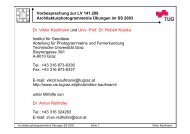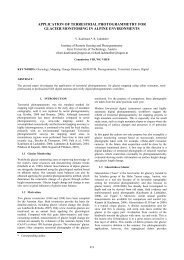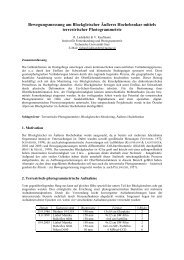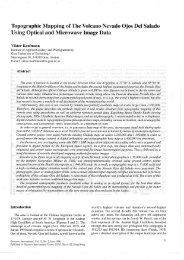computer animation of the retreat of two small cirque glaciers in the ...
computer animation of the retreat of two small cirque glaciers in the ...
computer animation of the retreat of two small cirque glaciers in the ...
You also want an ePaper? Increase the reach of your titles
YUMPU automatically turns print PDFs into web optimized ePapers that Google loves.
COMPUTER ANIMATION OF THE RETREAT OF TWO<br />
SMALL CIRQUE GLACIERS IN THE AUSTRIAN ALPS<br />
SINCE THE LITTLE ICE AGE ADVANCE OF 1850<br />
Viktor Kaufmann and Re<strong>in</strong>hard Plösch<br />
Institute <strong>of</strong> Geodesy and CIS, Graz University <strong>of</strong> Technology<br />
Steyrergasse 30, A-8010 Graz, Austria<br />
e-mail: viktor.kaufmann@tugraz.at<br />
Abstract<br />
The present video film describes <strong>the</strong> three-dimensional reconstruction <strong>of</strong> <strong>the</strong> <strong>retreat</strong> <strong>of</strong> <strong>two</strong> <strong>small</strong><br />
<strong>cirque</strong> <strong>glaciers</strong> (Goessnitzkees and Hornkees, Hohe Tauern range, Austria) and, fur<strong>the</strong>rmore, it<br />
shows, as a highlight, <strong>the</strong> dynamic change <strong>of</strong> glaciation by means <strong>of</strong> <strong>computer</strong> <strong>animation</strong>.<br />
1. Introduction<br />
The content <strong>of</strong> this video film refers to a research project [1, 2] which has been carried out by <strong>the</strong><br />
Institute <strong>of</strong> Geography and Regional Science, University <strong>of</strong> Graz, and <strong>the</strong> Institute <strong>of</strong> Geodesy,<br />
Graz University <strong>of</strong> Technology, with f<strong>in</strong>ancial support from <strong>the</strong> Hohe Tauern National Park<br />
Service. On <strong>the</strong> basis <strong>of</strong> mora<strong>in</strong>es (1850), old maps (1873, 1929) and metric aerial photographs<br />
(1954, 1969, 1974, 1983, 1992 and 1997) 9 different glacial stages were reconstructed. All relevant<br />
data <strong>of</strong> this time series are stored <strong>in</strong> a digital database. The spatio-temporal analysis <strong>of</strong> this database<br />
quantitatively revealed <strong>the</strong> course <strong>of</strong> deglaciation <strong>in</strong> respect to changes <strong>in</strong> area and volume.<br />
Fur<strong>the</strong>rmore, this digital database was also <strong>the</strong> data source for appropriate visualization <strong>of</strong> <strong>the</strong><br />
glacier <strong>retreat</strong>. S<strong>in</strong>ce dynamic processes are difficult to show us<strong>in</strong>g standard cartographic means,<br />
e.g. <strong>the</strong>matic maps, a <strong>computer</strong> <strong>animation</strong> <strong>of</strong> <strong>the</strong> glacier <strong>retreat</strong> (glacier history) was implemented.<br />
2. Visualization <strong>of</strong> <strong>the</strong> glacial stages <strong>in</strong> a dynamic mode<br />
Computer <strong>animation</strong> is used to visualize dynamic processes. In contrast to <strong>computer</strong> simulation,<br />
where ma<strong>the</strong>matical models provide numerical results, i.e. geometric properties are measurable,<br />
<strong>animation</strong> focuses on <strong>the</strong> graphical display <strong>of</strong> <strong>the</strong>se results for visual perception. Therefore data<br />
accuracy is not <strong>of</strong> prime importance. Fur<strong>the</strong>rmore, <strong>the</strong> amount <strong>of</strong> data has to be limited <strong>in</strong> order to<br />
keep <strong>the</strong> data manageable and process<strong>in</strong>g time low.<br />
In <strong>the</strong> present study <strong>the</strong> dynamic change <strong>of</strong> glaciation has to be shown <strong>in</strong> a time-accelerator. All<br />
necessary data for this type <strong>of</strong> visualization is available through <strong>the</strong> digital database. The grid
spac<strong>in</strong>g <strong>of</strong> <strong>the</strong> DTMs has been <strong>in</strong>creased to 15 m. S<strong>in</strong>ce only 9 glacial stages are available,<br />
irregularly distributed over <strong>the</strong> whole time period <strong>of</strong> 147 years, o<strong>the</strong>r <strong>in</strong>termediate glacial stages<br />
have to be <strong>in</strong>terpolated from <strong>the</strong>m, ei<strong>the</strong>r based on a scientific glacier flow model or any o<strong>the</strong>r<br />
simplified geometric model. The first refers to <strong>computer</strong> simulation, whereas <strong>the</strong> second is adequate<br />
for <strong>the</strong> proposed task, especially because <strong>the</strong>re was no <strong>the</strong>oretical glacier flow model available, at<br />
least for this type <strong>of</strong> <strong>small</strong> <strong>cirque</strong> glacier. In short, appropriate wireframe models <strong>of</strong> <strong>the</strong> surfaces can<br />
be generated on <strong>the</strong> basis <strong>of</strong> <strong>the</strong> DTMs. Any o<strong>the</strong>r "<strong>in</strong> between" glacial stage must be l<strong>in</strong>early<br />
<strong>in</strong>terpolated <strong>in</strong> vertical direction <strong>in</strong> respect to <strong>the</strong> given time mark. The computation <strong>of</strong> this<br />
dynamic (glacier) model was accomplished by <strong>the</strong> <strong>in</strong>terpolation module <strong>of</strong> <strong>the</strong> <strong>animation</strong> s<strong>of</strong>tware<br />
(Maya <strong>of</strong> Alias | Wavefront). For <strong>the</strong> visualization <strong>the</strong> s<strong>of</strong>tware computes images <strong>of</strong> <strong>the</strong> 3D model<br />
for <strong>the</strong> pre-def<strong>in</strong>ed time <strong>in</strong>terval, i.e. <strong>the</strong> frame rate. The visualization does not only need <strong>the</strong><br />
dynamic geometric model as <strong>in</strong>put but also <strong>in</strong>formation on illum<strong>in</strong>ation and surface properties <strong>of</strong><br />
<strong>the</strong> 3D object, both <strong>the</strong> glaciated and non-glaciated area. The <strong>animation</strong> s<strong>of</strong>tware allows <strong>the</strong><br />
selection <strong>of</strong> an appropriate light source, which can be positioned anywhere <strong>in</strong> <strong>the</strong> virtual space. The<br />
light source produces shades based on a Phong reflection model and, moreover, <strong>the</strong> relief <strong>of</strong> <strong>the</strong><br />
surface casts shadows, which <strong>in</strong>crease <strong>the</strong> visual perception <strong>of</strong> <strong>the</strong> 3D scene content. Surfaces are<br />
also associated with material properties, i.e. ei<strong>the</strong>r procedural or mapped shaders. Glaciers are<br />
shown us<strong>in</strong>g procedural shaders, i.e. without texture <strong>in</strong> cyan color, and non-glaciated areas are<br />
mapped by means <strong>of</strong> a draped digital image, i.e. <strong>the</strong> orthophoto <strong>of</strong> 1997 with a spatial resolution <strong>of</strong><br />
1 m. Once all those sett<strong>in</strong>gs have been def<strong>in</strong>ed, a virtual camera can be positioned <strong>in</strong> <strong>the</strong> scene.<br />
F<strong>in</strong>ally, <strong>the</strong> render<strong>in</strong>g program calculates all frames with<strong>in</strong> <strong>the</strong> specified time lapse as seen from <strong>the</strong><br />
camera position. Each frame is stored <strong>in</strong> a s<strong>in</strong>gle file, and subsequently transferred to a mass<br />
storage, i.e. a harddisk recorder (Pronto Video PV 24). The association with time <strong>in</strong> <strong>the</strong> <strong>animation</strong><br />
is achieved visually by an <strong>in</strong>serted animated icon, i.e. a digital clock count<strong>in</strong>g <strong>the</strong> years. In fact, an<br />
educational video film "glacier movie" (12:36) has been produced which covers <strong>the</strong> scope <strong>of</strong> this<br />
paper and, as a highlight, shows <strong>the</strong> <strong>retreat</strong> <strong>of</strong> both <strong>glaciers</strong> as a very realistic <strong>animation</strong>. The<br />
chosen monotonic sound track to <strong>the</strong> <strong>animation</strong> <strong>in</strong>tensifies quite well <strong>the</strong> visual impression <strong>of</strong> <strong>the</strong><br />
cont<strong>in</strong>uous glacier <strong>retreat</strong>. Short sequences <strong>of</strong> <strong>the</strong> <strong>computer</strong> <strong>animation</strong> can be downloaded from<br />
http://www.cis.tu-graz.ac.at/photo/viktor.kaufmann/. See also http://video.TUGraz.at/ for <strong>the</strong><br />
complete video film.<br />
3. References<br />
[1] KAUFMANN, V. and PLÖSCH, R., Reconstruction and Visualization <strong>of</strong> <strong>the</strong> Retreat <strong>of</strong> <strong>two</strong> Small Cirque Glaciers<br />
<strong>in</strong> <strong>the</strong> Austrian Alps s<strong>in</strong>ce 1850 – From Static Maps towards Dynamic Computer Animation, <strong>in</strong>: M. F. Buchroithner<br />
(ed.), High Mounta<strong>in</strong> Cartography 2000, Kartographische Bauste<strong>in</strong>e, Band 18, pages 239-253, Dresden 2000.<br />
[2] KAUFMANN, V. and LIEB, G.K., Investigations on <strong>the</strong> <strong>retreat</strong> <strong>of</strong> <strong>two</strong> <strong>small</strong> <strong>cirque</strong> <strong>glaciers</strong> (Goessnitzkees and<br />
Hornkees) <strong>in</strong> <strong>the</strong> Austrian Alps, Europe. Proceed<strong>in</strong>gs <strong>of</strong> <strong>the</strong> 5 th International Symposium on High Mounta<strong>in</strong> Remote<br />
Sens<strong>in</strong>g Cartographie (HMRSC-V), 24-25 August, 1998, Humboldt State University, Arcata, California, USA, <strong>in</strong><br />
pr<strong>in</strong>t.








